[1]
R. Kellermann, D. Taroata, A. Maltenberger, D. Hartmann, C.J. Brabec, G. Schmid, Low-cost copper complexes as p-dopants in solution processable hole transport layers, Appl. Phys. Lett. 107 (2015) 103305. https://doi.org/10.1063/1.4930237.
DOI: 10.1063/1.4930237
Google Scholar
[2]
F. So, J. Kido, P. Burrows, Organic Light-Emitting Devices for Solid-State Lighting, MRS Bull. 33 (2008) 663–669. https://doi.org/10.1557/MRS2008.137.
DOI: 10.1557/mrs2008.137
Google Scholar
[3]
Z. Zhang, M. Liao, H. Lou, Y. Hu, X. Sun, H. Peng, Conjugated Polymers for Flexible Energy Harvesting and Storage, Adv. Mater. 30 (2018) 1704261. https://doi.org/10.1002/ADMA.201704261.
DOI: 10.1002/adma.201704261
Google Scholar
[4]
B. Geffroy, P. le Roy, C. Prat, Organic light-emitting diode (OLED) technology: materials, devices and display technologies, Polym. Int. 55 (2006) 572–582. https://doi.org/10.1002/PI. (1974).
DOI: 10.1002/pi.1974
Google Scholar
[5]
J. Locklin, D. Li, S.C.B. Mannsfeld, E.J. Borkent, H. Meng, R. Advincula, Z. Bao, Organic Thin Film Transistors Based on Cyclohexyl-Substituted Organic Semiconductors, Chem. Mater. 17 (2005) 3366–3374. https://doi.org/10.1021/CM047851G.
DOI: 10.1021/cm047851g
Google Scholar
[6]
Naraso, J.I. Nishida, D. Kumaki, S. Tokito, Y. Yamashita, High performance n- and p-type field-effect transistors based on tetrathiafulvalene derivatives, J. Am. Chem. Soc. 128 (2006) 9598–9599. https://doi.org/10.1021/JA0630083.
DOI: 10.1021/ja0630083
Google Scholar
[7]
S. Ando, R. Murakami, J.I. Nishida, H. Tada, Y. Inoue, S. Tokito, Y. Yamashita, n-type organic field-effect transistors with very high electron mobility based on thiazole oligomers with trifluoromethylphenyl groups, J. Am. Chem. Soc. 127 (2005) 14996–14997. https://doi.org/10.1021/JA055686F/SUPPL_FILE/JA055686FSI20050922_011725.PDF.
DOI: 10.1021/ja055686f
Google Scholar
[8]
C.A. Di, G. Yu, Y. Liu, X. Xu, D. Wei, Y. Song, Y. Sun, Y. Wang, D. Zhu, J. Liu, X. Liu, D. Wu, High-performance low-cost organic field-effect transistors with chemically modified bottom electrodes, J. Am. Chem. Soc. 128 (2006) 16418–16419. https://doi.org/10.1021/JA066092V.
DOI: 10.1021/ja066092v
Google Scholar
[9]
C.A. Di, G. Yu, Y. Liu, D. Zhu, High-Performance Organic Field-Effect Transistors: Molecular Design, Device Fabrication, and Physical Properties, J. Phys. Chem. B. 111 (2007) 14083–14096. https://doi.org/10.1021/JP071753B.
DOI: 10.1021/jp071753b
Google Scholar
[10]
L. Torsi, A. Dodabalapur, Organic thin-film transistors as plastic analytical sensors, Anal. Chem. 77 (2005). https://doi.org/10.1021/AC053475N.
DOI: 10.1021/ac053475n
Google Scholar
[11]
Z.T. Zhu, J.T. Mason, R. Dieckmann, G.G. Malliaras, Humidity sensors based on pentacene thin-film transistors, Appl. Phys. Lett. 81 (2002) 4643. https://doi.org/10.1063/1.1527233.
DOI: 10.1063/1.1527233
Google Scholar
[12]
J.A. Rogers, Z. Bao, K. Baldwin, A. Dodabalapur, B. Crone, V.R. Raju, V. Kuck, H. Katz, K. Amundson, J. Ewing, P. Drzaic, Paper-like electronic displays: large-area rubber-stamped plastic sheets of electronics and microencapsulated electrophoretic inks, Proc. Natl. Acad. Sci. U. S. A. 98 (2001) 4835–4840. https://doi.org/10.1073/PNAS.091588098.
DOI: 10.1073/pnas.091588098
Google Scholar
[13]
G.H. Gelinck, H.E.A. Huitema, E. Van Veenendaal, E. Cantatore, L. Schrijnemakers, J.B.P.H. Van Der Putten, T.C.T. Geuns, M. Beenhakkers, J.B. Giesbers, B.H. Huisman, E.J. Meijer, E.M. Benito, F.J. Touwslager, A.W. Marsman, B.J.E. Van Rens, D.M. De Leeuw, Flexible active-matrix displays and shift registers based on solution-processed organic transistors, Nat. Mater. 3 (2004) 106–110. https://doi.org/10.1038/NMAT1061.
DOI: 10.1038/nmat1061
Google Scholar
[14]
M.M. Ling, Z. Bao, Thin Film Deposition, Patterning, and Printing in Organic Thin Film Transistors, Chem. Mater. 16 (2004) 4824–4840. https://doi.org/10.1021/CM0496117.
DOI: 10.1021/cm0496117
Google Scholar
[15]
Y. Don Park, J.A. Lim, H.S. Lee, K. Cho, Interface engineering in organic transistors, Mater. Today. 10 (2007) 46–54. https://doi.org/10.1016/S1369-7021(07)70019-6.
DOI: 10.1016/s1369-7021(07)70019-6
Google Scholar
[16]
H. Sirringhaus, Device Physics of Solution-Processed Organic Field-Effect Transistors, Adv. Mater. 17 (2005) 2411–2425. https://doi.org/10.1002/ADMA.200501152.
DOI: 10.1002/adma.200501152
Google Scholar
[17]
K. Walzer, B. Männig, M. Pfeiffer, K. Leo, Highly Efficient Organic Devices Based on Electrically Doped Transport Layers, Chem. Rev. 107 (2007) 1233–1271. https://doi.org/10.1021/CR050156N.
DOI: 10.1021/cr050156n
Google Scholar
[18]
Y. Shirota, Organic materials for electronic and optoelectronic devices, J. Mater. Chem. 10 (2000) 1–25. https://doi.org/10.1039/A908130E.
Google Scholar
[19]
E. Tanış, E. Babur Sas, B. Gündüz, M. Kurt, Required theoretical and experimental physical characteristics of tris[4-(diethylamino)phenyl] amine organic material, J. Mater. Sci. Mater. Electron. 29 (2018) 16111–16119. https://doi.org/10.1007/S10854-018-9700-1.
DOI: 10.1007/s10854-018-9700-1
Google Scholar
[20]
T. Ueno, T. Nagano, Fluorescent probes for sensing and imaging., Nat. Methods. 8 (2011) 642–645. https://doi.org/10.1038/nmeth.1663.
DOI: 10.1038/nmeth.1663
Google Scholar
[21]
M.S.T. Gonçalves, Fluorescent Labeling of Biomolecules with Organic Probes, Chem. Rev. 109 (2009) 190–212. https://doi.org/10.1021/cr0783840.
DOI: 10.1021/cr0783840
Google Scholar
[22]
L.D. Lavis, R.T. Raines, Bright Ideas for Chemical Biology, ACS Chem. Biol. 3 (2008) 142–155. https://doi.org/10.1021/cb700248m.
DOI: 10.1021/cb700248m
Google Scholar
[23]
L.D. Lavis, R.T. Raines, Bright Building Blocks for Chemical Biology, ACS Chem. Biol. 9 (2014) 855–866. https://doi.org/10.1021/cb500078u.
DOI: 10.1021/cb500078u
Google Scholar
[24]
L.M. Wysocki, L.D. Lavis, Advances in the chemistry of small molecule fluorescent probes., Curr. Opin. Chem. Biol. 15 (2011) 752–759. https://doi.org/10.1016/j.cbpa.2011.10.013.
DOI: 10.1016/j.cbpa.2011.10.013
Google Scholar
[25]
K.J. de Almeida, T.C. Ramalho, Z. Rinkevicius, O. Vahtras, H. Agren, A. Cesar, Theoretical study of specific solvent effects on the optical and magnetic properties of copper(II) acetylacetonate., J. Phys. Chem. A. 115 (2011) 1331–1339. https://doi.org/10.1021/ jp109826p.
DOI: 10.1021/jp109826p
Google Scholar
[26]
Y. Gülseven Sıdır, I. Sıdır, E. Taşal, E. Ermiş, Studies on the electronic absorption spectra of some monoazo derivatives., Spectrochim. Acta. A. Mol. Biomol. Spectrosc. 78 (2011) 640–647. https://doi.org/10.1016/j.saa.2010.11.040.
DOI: 10.1016/j.saa.2010.11.040
Google Scholar
[27]
D. Kosenkov, L. V Slipchenko, Solvent effects on the electronic transitions of p-nitroaniline: a QM/EFP study., J. Phys. Chem. A. 115 (2011) 392–401. https://doi.org/10.1021/ jp110026c.
DOI: 10.1021/jp110026c
Google Scholar
[28]
O.A. Adegoke, O.S. Idowu, Solvatochromic behaviours and structure–spectra relationships of 4-carboxyl-2,6-dinitrophenylazohydroxynaphthalenes, Spectrochim. Acta Part A Mol. Biomol. Spectrosc. 75 (2010) 719–727. https://doi.org/https://doi.org/10.1016/j.saa. 2009.11.045.
DOI: 10.1016/j.saa.2009.11.045
Google Scholar
[29]
B. Gündüz, Effects of molarity and solvents on the optical properties of the solutions of tris[4-(5-dicyanomethylidenemethyl-2-thienyl)phenyl]amine (TDCV-TPA) and structural properties of its film, Opt. Mater. (Amst). 36 (2013) 425–436. https://doi.org/10.1016/J.OPTMAT.2013.10.005.
DOI: 10.1016/j.optmat.2013.10.005
Google Scholar
[30]
N. Pandey, M.S. Mehata, S. Pant, N. Tewari, Structural, Electronic and NLO Properties of 6-aminoquinoline: A DFT/TD-DFT Study, J. Fluoresc. 31 (2021) 1719–1729. https://doi.org/10.1007/s10895-021-02788-z.
DOI: 10.1007/s10895-021-02788-z
Google Scholar
[31]
U. Subuddhi, S. Haldar, S. Sankararaman, A. Mishra, Photophysical behaviour of 1-(4-N,N-dimethylaminophenylethynl)pyrene (DMAPEPy) in homogeneous media, Photochem. Photobiol. Sci. 5 (2006) 459–466. https://doi.org/10.1039/b600009f.
DOI: 10.1039/b600009f
Google Scholar
[32]
P. Horváth, P. Šebej, T. Šolomek, P. Klán, Small-Molecule Fluorophores with Large Stokes Shifts: 9-Iminopyronin Analogues as Clickable Tags, J. Org. Chem. 80 (2015) 1299–1311. https://doi.org/10.1021/jo502213t.
DOI: 10.1021/jo502213t
Google Scholar
[33]
M.H.W. Stopel, C. Blum, V. Subramaniam, Excitation Spectra and Stokes Shift Measurements of Single Organic Dyes at Room Temperature, J. Phys. Chem. Lett. 5 (2014) 3259–3264. https://doi.org/10.1021/jz501536a.
DOI: 10.1021/jz501536a
Google Scholar



